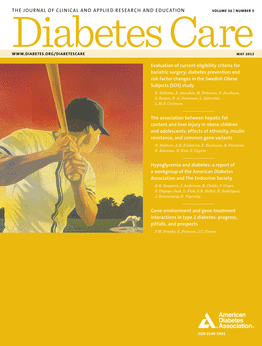Diabetes Care:大连医科大学附一院杜建玲发现2型糖尿病强化多因素干预可以达到大血管病变的一级预防
2013-05-10 Diabetes Care dxy
为了探讨在新近诊断的2型糖尿病患者,强化多因素干预是否能够预防大血管疾病,来自大连医科大学附属第一医院内分泌科的杜建玲教授及其团队进行了一项研究,该研究发现通过对病程短的2型糖尿病患者进行强化多因素干预,可以达到大血管疾病的一级预防。该研究结果发表在2013年4月的美国《糖尿病治疗》(Diabetes Care)杂志上,该杂志影响因子为8.087。该研究中,共有150例病程小于1年,通过超声扫描3
为了探讨在新近诊断的2型糖尿病患者,强化多因素干预是否能够预防大血管疾病,来自大连医科大学附属第一医院内分泌科的杜建玲教授及其团队进行了一项研究,该研究发现通过对病程短的2型糖尿病患者进行强化多因素干预,可以达到大血管疾病的一级预防。该研究结果发表在2013年4月的美国《糖尿病治疗》(Diabetes Care)杂志上,该杂志影响因子为8.087。
该研究中,共有150例病程小于1年,通过超声扫描3条大动脉不伴有临床动脉硬化性疾病或亚临床动脉硬化迹象的2型糖尿病患者,被随机分为强化干预组和常规干预组。然后,他们接受强化多因素干预或常规干预随访7年以上。每年测量患者的颈总动脉内膜中层厚度(CC–IMTs)。主要结果是在颈动脉第一次发现CC–IMTs≥1.0mm和/或动脉粥样硬化斑块进展的时间。次要结果是心血管疾病的临床证据。
该研究结果表明,共有70例强化组患者和68例常规组患者完成了7年随访。强化组中7例和常规阻中22例发生亚临床大血管病变(主要结果),累积患病率分别为10.00%和32.35%(P<0.05)。两组之间观察到的次要结果没有显著差异。
该研究发现,通过对病程短的2型糖尿病患者进行强化多因素干预,可以达到大血管疾病的一级预防。2型糖尿病患者应该进行个体化目标的强化多因素干预,预防大血管疾病。
与糖尿病相关的拓展阅读:
- Stroke:糖尿病患者卒中发生风险增高
- Diabetes Care:循环25(OH)D与2型糖尿病风险呈负相关
- GLP-1类糖尿病药物的胰腺炎风险引起监管机构重视
- Diabetes Care:糖尿病视网膜病和微量白蛋白尿可预测T2DM患者大量白蛋白尿和肾功能减退
- NEJM:糖尿病治疗领域的进展与不足
- JAMA:研究支持对糖尿病患者进行更强力的抗血小板治疗 更多信息请点击:有关糖尿病更多资讯

Primary prevention of macroangiopathy in patients with short-duration type 2 diabetes by intensified multifactorial intervention: seven-year follow-up of diabetes complications in Chinese.
OBJECTIVE
To explore whether intensified, multifactorial intervention could prevent macrovascular disease in patients with recently diagnosed type 2 diabetes.
RESEARCH DESIGN AND METHODS
A total of 150 type 2 diabetic patients, with disease duration of <1 year and without clinical arteriosclerotic disease or subclinical atherosclerotic signs confirmed by ultrasonographic scanning of three conducting arteries, were randomized into an intensive intervention group and a conventional intervention group. They then received intensive, multifactorial intervention or conventional intervention over 7 years of follow-up. The patients' common carotid intima-media thicknesses (CC-IMTs) were measured every year. The primary outcome was the time to the first occurrence of CC-IMTs ≥1.0 mm and/or development of atherosclerosis plaques in the carotid artery. The secondary outcome was clinical evidence of cardiovascular disease.
RESULTS
A total of 70 patients in the intensive group and 68 patients in the conventional group completed the 7-year follow-up. Subclinical macrovascular (primary) outcomes occurred in seven cases in the intensive group and 22 cases in the conventional group for a cumulative prevalence of 10.00 and 32.35%, respectively (P < 0.05). No significant differences between the two groups were observed regarding the secondary outcome.
CONCLUSIONS
Primary prevention of macrovascular diseases can be achieved through intensified, multifactorial intervention in patients with short-duration type 2 diabetes. Type 2 diabetic patients should undergo intensive multifactorial interventions with individual targets for the prevention of macrovascular diseases.
作者:Diabetes Care
版权声明:
本网站所有注明“来源:梅斯医学”或“来源:MedSci原创”的文字、图片和音视频资料,版权均属于梅斯医学所有。非经授权,任何媒体、网站或个人不得转载,授权转载时须注明“来源:梅斯医学”。其它来源的文章系转载文章,本网所有转载文章系出于传递更多信息之目的,转载内容不代表本站立场。不希望被转载的媒体或个人可与我们联系,我们将立即进行删除处理。
在此留言





#BET#
62
#医科大学#
69
#血管病#
57
#DIA#
64
#大血管#
63